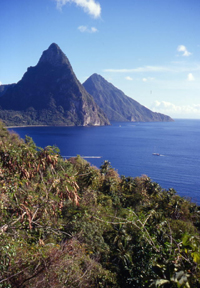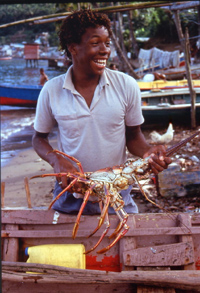Great Fishwatching Vacations
St. Lucia, Caribbean: Soufrièere Marine Management Area
Soufrière, home to ten thousand people on the West Indian island of St. Lucia, lies cupped within a protecting crescent of forested mountains. From the sea it is guarded by the Pitons, bleached granite monoliths that tower two and a half thousand feet over the Caribbean. The breeze wafts scents of jasmine across the bay from trees that cling to their sheer slopes, sharpened by sulphur fumes from the volcano hidden in the hills behind. It appears as a vision of paradise, but when I first visited in 1994 the fishers who lived there were far from happy. Beneath the water that lapped the Pitons, the fish they depended on had nearly disappeared.

Diving for the first time in Soufrière Bay, I could quickly appreciate their concern. Schools of damselfish shimmered about the corals and delicate wrasse picked among seaweeds, but there were few animals above the size of my hand. Although I searched hard, I saw no big groupers haunting the ledges and caves and no large snappers stalking prey. Nor were there the dense shoals of grunts familiar to me from Belizean reefs. The reef was eerily devoid of large predatory fish. The reason for their absence was simple, if unexpected. Armed only with the simplest of fishing methods – wooden canoes, hook and line, spear and trap – local fishers had managed to severely overexploit their quarry. But all this would soon change, they hoped.
I had come to St. Lucia to witness the beginning of a bold new management effort. They were about to set aside a third of their fishing grounds in a network of marine reserves interspersed with areas in which they could continue to fish. The marine reserves would, they had been told, provide refuges in which fish could live longer, grow larger and become more numerous. If the managers were right, those reserves would repopulate surrounding fishing grounds through export of the eggs and larvae of large fish and emigration of young fish. Protection was to be implemented by a dedicated park manager and his enthusiastic crew of rangers.

Over the ensuing years, I returned each summer with a team of fish counters to record progress. We were unprepared for the speed with which benefits of protection became apparent. Within a year we detected a significant increase in the amount of commercially important fish present. Those gains continued year on year, surviving initial local protests, political change and the damage wrought by hurricane waves. Beyond the pleasure we gained as scientists from proving theories correct, it was a joy to see the reefs filling up again. Predatory eyes once again peered from the dark recesses of the reef and shoals of snappers coalesced around promontories. After a few years, herds of grazing parrotfish and surgeonfish once again munched their way across reef slopes. Rare animals became common, common animals abundant, and small fish grew large. It was also deeply pleasing to see the sacrifice made by poor fishers rewarded by steadily growing catches. Five years after the onset of protection, trap catches were up by 46-90%, and the profitability of fishing had grown by a similar amount to unpublished data.
Since then, life for fish and those who pursue them has continued to improve. After eight years of protection, stocks of commercial fish had risen by five times in reserves and two and-a-half times in fishing grounds and there is little sign as yet of levelling off. Experiences from other parts of the world suggest that benefits of protection will continue to grow for decades as large and long-lived species recolonize and grow, and habitats recover from the effects of fishing.
There are several good hotels in Soufriere, such as the upmarket Anse Chastanet Hotel, the middle-range Hummingbird as well as more budget priced options.
